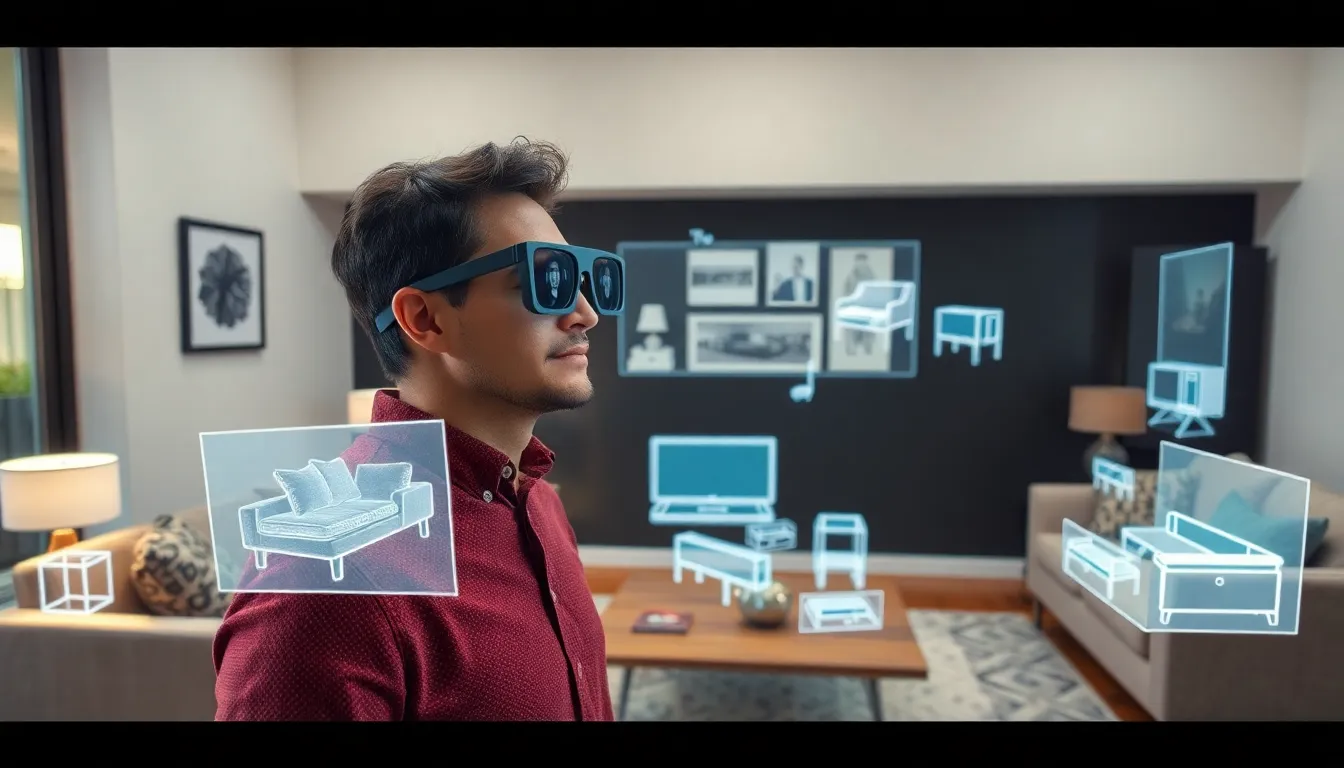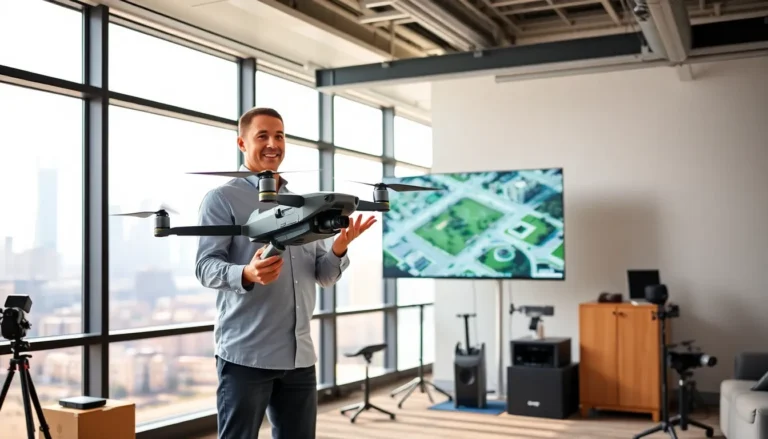Imagine stepping into a world where digital and physical realities collide, creating a playground for your imagination. Augmented Reality (AR) interaction isn’t just a tech buzzword; it’s a game-changer that’s reshaping how we engage with our surroundings. From swiping right on a virtual couch to trying on sunglasses without stepping foot in a store, AR brings a sprinkle of magic to everyday life.
Table of Contents
ToggleOverview of AR Interaction
AR interaction blends digital elements with the physical world, creating an immersive experience. Users engage with virtual information overlaid on real-world objects. This technology transforms how people interact with their environment, enhancing both shopping and educational experiences.
In retail, AR applications allow customers to visualize products in their own space. For example, furniture retailers provide tools for customers to see how a couch fits into their living room. Similarly, beauty brands offer apps that let users see how products look on their skin.
Education benefits significantly from AR interaction as well. Students can explore complex concepts through interactive 3D models. Certain AR platforms enable learners to interact with historical artifacts or scientific phenomena, fostering deeper understanding.
Health care utilizes AR for enhanced training and improved patient care. Surgeons can review a patient’s anatomy through AR visuals during procedures. Medical students benefit from simulated surgeries, allowing them to practice in a controlled environment.
Tourism experiences also become richer with AR interaction. Travelers use AR apps to gain insights into landmarks and exhibits by pointing their devices at them. This technology fosters a meaningful connection between visitors and the history of locations.
AR interaction continues to evolve, opening doors to innovative applications across various industries. Enhanced user engagement and dynamic content delivery remain central to its ongoing development. With these advancements, AR reshapes how individuals connect with their surroundings and enhances everyday interactions.
Key Technologies in AR Interaction

Several technologies underpin AR interaction, enabling seamless integration of digital and physical elements. These technologies enhance user engagement and expand possibilities across various industries.
Computer Vision
Computer vision plays a crucial role in AR, allowing devices to interpret and understand visual information from the real world. It helps identify objects, recognize patterns, and track movements. Algorithms analyze images captured by cameras to overlay digital content accurately in real time. Enhanced spatial awareness improves interaction quality, particularly in scenarios like furniture visualization and navigation in unfamiliar environments. Leading companies employ computer vision in AR applications to provide immersive experiences that captivate users and enrich their interactions.
Input Methods
Input methods significantly impact AR interaction, providing avenues for users to engage with augmented content. Touchscreens allow for quick selections and gestures, while voice commands enhance accessibility and convenience. Gesture recognition technology enables users to manipulate virtual elements through natural movements, creating a more intuitive experience. Furthermore, eye-tracking empowers applications to respond to user focus, offering personalized content based on attention. Collectively, these input methods contribute to a rich interaction landscape, ensuring AR experiences remain engaging and fluid.
Benefits of AR Interaction
Augmented Reality (AR) interaction offers numerous benefits that enhance user experiences across various sectors.
Enhanced User Engagement
Engagement rises as users interact with digital elements in their real-world environments. By augmenting real spaces with interactive content, users immerse themselves in experiences that traditional formats can’t provide. Consumers find it easier to connect with brands when they can visualize products in their own settings. Studies show that AR can increase conversion rates by up to 90%, significantly impacting sales. Interactivity fosters a deeper emotional connection, encouraging users to explore and enjoy content rather than passively consume it. Educational institutions leverage this benefit to facilitate learning, allowing students to engage with material dynamically.
Real-World Applications
Various industries utilize AR to enhance overall experiences. In retail, customers visualize how products fit into their lives. Furniture stores enable shoppers to place virtual couches in their homes before purchase. Healthcare professionals employ AR for enhanced surgical precision, displaying vital information in real-time. Tourism apps provide enriched experiences, offering detailed information about landmarks as users explore. Furthermore, AR transforms educational settings by allowing students to interact with 3D models of complex concepts, improving comprehension and retention. Such applications highlight AR’s versatility and its potential to revolutionize how individuals interact with their environments.
Challenges in AR Interaction
AR interaction faces several challenges that impact its effectiveness and user adoption.
Technical Limitations
Technical limitations present significant hurdles for AR applications. Many devices struggle with processing power, which affects graphics quality and responsiveness. Limited connectivity can also hinder AR performance, as weak internet signals lead to lag or disconnection during use. Battery life remains a concern since AR applications often require intensive processing, draining energy quickly. Compatibility issues between devices can restrict access, preventing users from experiencing seamless interaction. Developing more advanced hardware and software solutions can address these limitations and improve user experiences significantly.
User Experience Concerns
User experience concerns affect the overall effectiveness of AR interactions. Some users find AR applications disorienting or overwhelming, especially when digital elements clutter the physical environment. Usability issues may arise, leading to frustration if the interfaces lack intuitiveness. Clear onboarding processes are crucial to ensure users understand how to navigate and interact effectively. Moreover, privacy concerns can arise when applications utilize location data and camera access, causing apprehension among users. Prioritizing user-centered design and continuous feedback integration can enhance the AR experience, fostering wider acceptance and engagement.
Future Trends in AR Interaction
Emerging trends in AR interaction point to a more seamless integration of digital elements into everyday life. Advances in artificial intelligence enhance AR’s personalization, enabling tailored experiences based on users’ preferences and behaviors. Enhanced computer vision capabilities allow for a more accurate understanding of physical environments, promoting real-time interactions with digital overlays.
Smart glasses, such as those developed by major tech companies, play a pivotal role in the future of AR. These devices could replace smartphones as primary interaction tools, providing hands-free access to augmented experiences. Increased connectivity through 5G networks facilitates faster data transmission, reducing latency and improving user engagement.
The gaming industry continues to drive AR innovation, with developers creating immersive environments that blend physical and virtual elements. Interactive gaming experiences foster social connections, enabling players to interact in shared spaces while engaging with digital content. Medical training programs incorporate AR simulations for realistic hands-on experiences, enhancing skills acquisition in a safe environment.
Industries such as agriculture adopt AR solutions to optimize productivity. Farmers use augmented overlays to visualize soil health and crop conditions, making data-driven decisions. Retailers embrace AR as a means of enhancing customer service, allowing users to see how products fit into their lives before making a purchase.
Privacy and user experience concerns must remain a priority. Ensuring secure data handling practices builds trust and encourages adoption of AR technologies. Continuous user-centered design keeps the experiences intuitive, reducing frustration and uncertainty for users.
AR interaction is redefining how individuals engage with their environments. By seamlessly blending digital elements with the physical world, it creates immersive experiences that enhance learning, shopping, and even healthcare. As industries embrace this technology, the potential for deeper emotional connections and improved user engagement becomes evident.
However, challenges remain. Addressing technical limitations and user experience issues is crucial for widespread adoption. As advancements in AI and computer vision continue to evolve, the future of AR interaction looks promising. With smart glasses and enhanced connectivity on the horizon, the possibilities for enriching everyday life are limitless. Embracing these innovations while prioritizing privacy will pave the way for a more integrated and engaging digital future.





